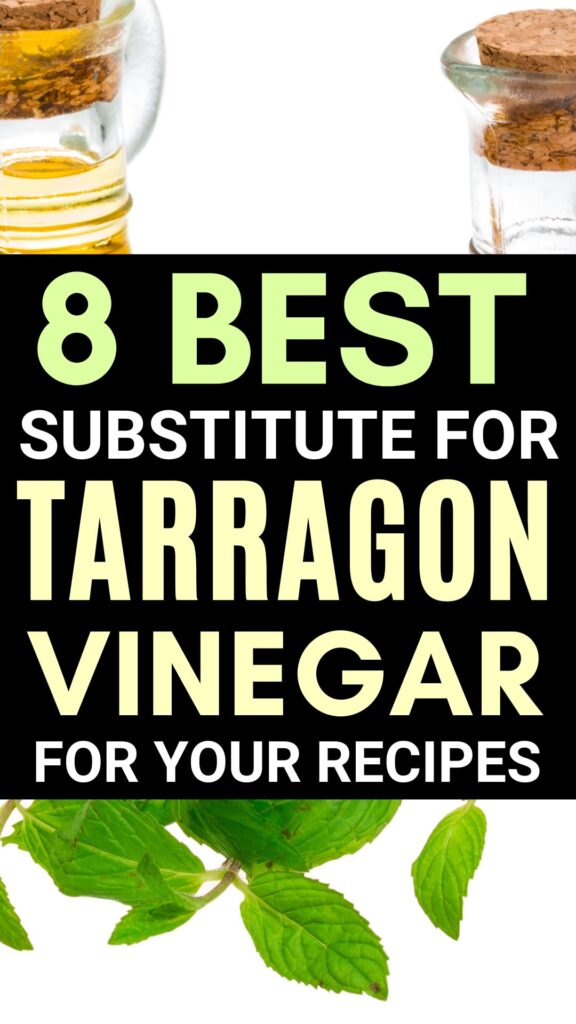If you’re a fan of French cuisine, you’re probably familiar with tarragon vinegar. This vinegar infuses white wine vinegar with fresh tarragon leaves, giving it a distinct anise-like flavor. Tarragon vinegar is commonly used in salad dressings, marinades, and sauces. But what if you don’t have any tarragon vinegar on hand? Don’t worry, and several substitutes can be used instead.

What is Tarragon Vinegar?
If you are a fan of French cuisine, you have probably come across tarragon vinegar. Tarragon vinegar is a flavored vinegar made by steeping fresh tarragon leaves in vinegar. The result is a tangy and slightly sweet vinegar that adds flavor to salads, marinades, and sauces.
Tarragon vinegar is a staple ingredient in French cuisine, particularly in classic dishes such as béarnaise sauce and chicken tarragon. It is also commonly used in salad dressings, vinaigrettes, and marinades.
Tarragon vinegar uses white wine vinegar or apple cider vinegar as a base. Fresh tarragon leaves are steeped in vinegar for several weeks to infuse the flavor. The longer the tarragon is left to steep, the stronger the vinegar flavor.
Why Substitute Tarragon Vinegar?
If you’re looking for a substitute for tarragon vinegar, there are a few reasons you might be considering it. Perhaps you don’t have tarragon vinegar on hand, or you’re looking for a more affordable option.
One reason to consider a substitute for tarragon vinegar is that it can be challenging to find in some areas. While some specialty food stores may carry it, it may not be available at your local grocery store. Additionally, tarragon vinegar can be more expensive than other types of vinegar, which may make it less practical for some home cooks.
Another reason to consider a substitute for tarragon vinegar is that it may not be the best choice for every recipe.
Best Substitutes for Tarragon Vinegar
One of the best substitutes for tarragon vinegar is white wine vinegar. This vinegar has a similar flavor profile to tarragon vinegar but without the herbal notes. It’s made from white wine that has been fermented and aged, giving it a slightly sweet and tangy taste. Other alternatives like Malt vinegar, apple cider vinegar, and balsamic vinegar also work well.
When you don’t have tarragon vinegar on hand, there are a few substitutes that you can use in your recipes. Here are some of the best substitutes for tarragon vinegar:
1. White Wine Vinegar
White wine vinegar is one of the best substitutes for tarragon vinegar. It has a similar flavor profile and is often used to make tarragon vinegar. You can use it in salad dressings, marinades, and sauces.
White vinegar is very close to Tarragon Vinegar. If you have Tarragon leaves, you can make your one Tarragon Vinegar. Add 1-2 cups of Tarragon leaves and pour White wine vinegar over it. Let it sit for 2-3 weeks, and you will have your own Tarragon Vinegar.
White wine vinegar works well with cold dishes like dips and dressings to give a tangy flavor.
Use it in a 1:1 ratio. For one tablespoon of Tarragon Vinegar, add one tablespoon of White wine vinegar.
2. Rice Vinegar
It has a mild flavor and is less acidic than other types of vinegar. It works well in Asian-inspired dishes and can be used instead of tarragon vinegar in sauces and dressings.
Due to its mildness, you may have to add more rice vinegar than Tarragon Vinegar to dishes. Rice vinegar is also an excellent option for salads and dressings as it provides a milder taste without being too sharp.
Use it in a 1:1 ratio to Tarragon vinegar. For each tablespoon of Tarragon Vinegar, use 1 tablespoon of Rice vinegar.
3. Apple Cider Vinegar
Apple cider vinegar is a popular vinegar that can be used as a substitute for tarragon vinegar. It has a slightly sweet and tangy flavor that pairs well with dishes. It works well in salad dressings and marinades, where you will not mind the fruity taste of apples.
Apple cider vinegar gets its sweet taste and flavor from apples. It has a sharp flavor than Tarragon Vinegar.
Due to its sharp taste and flavor, use it sparingly.
Use 1/4 tablespoon or 1 teaspoon of apple cider vinegar for each Tarragon Vinegar.
4. Lemon Juice
Lemon juice is a good substitute for tarragon vinegar to add acidity to your dish. It has a bright, citrusy flavor that can complement the flavors of tarragon. You can use it in salad dressings, marinades, and sauces.
Lemon juice provides the required tanginess and acidic taste, and health benefits. It is full of Vitamin C and antioxidants.
You can use it in a ratio of 1:1. For every tablespoon of Tarragon Vinegar, use one tablespoon of Lemon juice.
5. Champagne Vinegar
Champagne vinegar is a mild vinegar that can be used as a substitute for tarragon vinegar. It has a slightly sweet flavor and is often used in salad dressings and marinades.
It is an excellent option for drizzling over salads or for making dressings. It pairs well with leafy greens and seafood.
Use Champagne vinegar in 1:1 ratio to Tarragon Vinegar. For each tablespoon of Tarragon Vinegar, use 1 tablespoon of Champagne vinegar.
6. Malt Vinegar
Malt vinegar is a strong vinegar that can be used in savory dishes. It has a distinct flavor that can add depth to your recipes. It is made from barley grains and has an acidic taste, tangy and toasty flavor.
Malt vinegar is readily available and a great substitute that provides herbal notes along with tangy flavors. It is best for Vinaigrettes, marinades, and sauces and is good to sprinkle over chips.
Use Malt vinegar in a 1:1 ratio to Tarragon vinegar for best results. For one tablespoon of Tarragon Vinegar, use 1 tablespoon of Malt Vinegar.
7. Balsamic Vinegar
Balsamic vinegar is a good substitute for tarragon vinegar if you want a sweeter flavor. It has a complex sweet and tart flavor profile and can be used in salad dressings, marinades, and sauces.
It is a bit thicker and darker than Tarragon Vinegar. Also, it has a fruity flavor, while the Tarragon vinegar has herbal notes.
Due to its thicker consistency and intense flavor, use one teaspoon of Balsamic vinegar to one tablespoon of Tarragon flavor.
8. Sherry Vinegar
Sherry vinegar has a more complex flavor than tarragon vinegar, with notes of sweetness and nuttiness. Sherry vinegar is aged and commonly used in Spanish cooking. It is an excellent substitute for tarragon vinegar, adding depth to many dishes without overpowering them.
To substitute for tarragon vinegar, use sherry vinegar in a 1:1 ratio.
Best applesauce substitutes for cooking and baking
Can I Substitute Balsamic Vinegar for Tarragon Vinegar?
The answer is yes, balsamic vinegar can be used as a substitute for tarragon vinegar, but there are a few things to remember. It is essential to note that balsamic vinegar has a much stronger flavor than tarragon vinegar. You must use less balsamic vinegar than tarragon vinegar in your recipes. Start by using half the amount of balsamic vinegar called for in the recipe and adjust to taste.
Also, balsamic vinegar has a dark color and a sweet, tangy flavor that may not be suitable for all recipes. For example, balsamic vinegar may overpower the other flavors if you make a light vinaigrette for a salad. In this case, you might consider using lighter vinegar, such as white wine or champagne vinegar.
However, balsamic vinegar can be an excellent substitute for tarragon vinegar in recipes that require a robust and bold flavor. For example, balsamic vinegar works well in marinades for meat or vegetables and sauces for pasta or roasted vegetables.
Here is a quick summary of the pros and cons of using balsamic vinegar as a substitute for tarragon vinegar:
Pros:
- Strong, bold flavor
- Works well in marinades and sauces
Cons:
- The dark color may not be suitable for all recipes.
- The sweet, tangy flavor may overpower other flavors.
Balsamic vinegar can be a good substitute for tarragon vinegar in specific recipes, but it is essential to use it judiciously and adjust to taste.
What does tarragon vinegar taste like?
Tarragon vinegar is a type of vinegar that is infused with tarragon leaves. It has a distinctive sweet and slightly bitter flavor with a hint of anise or licorice. The taste of tarragon vinegar can be described as tangy, herbaceous, and slightly acidic.
When used in cooking, tarragon vinegar can uniquely flavor dishes. It is commonly used in salad dressings, marinades, and sauces. Tarragon vinegar can also flavor roasted vegetables, chicken, and fish.
Here are some of the flavor notes of tarragon vinegar:
- Sweet: Tarragon vinegar has a sweet flavor from the tarragon leaves.
- Bitter: The bitterness of tarragon vinegar comes from the vinegar itself.
- Anise or Licorice: Tarragon has a distinct anise or licorice flavor in tarragon vinegar.
- Tangy: The acidity of tarragon vinegar gives it a tangy flavor.
- Herbaceous: Tarragon vinegar has a strong herbal flavor from tarragon leaves.
Tarragon vinegar has a complex flavor profile that can add depth and complexity to dishes. If you don’t have tarragon vinegar on hand, there are several substitutes that you can use to achieve a similar flavor.

Is Tarragon Vinegar Malt Vinegar?
When it comes to vinegar, many different types are available, each with a unique flavor profile. Tarragon vinegar steeps fresh tarragon leaves in vinegar, usually white wine vinegar. On the other hand, malt vinegar is made from barley and other grains that are left to steep and then distilled.
While both vinegars have a sour taste, they have distinct differences in flavor. Tarragon vinegar has a subtle anise flavor that pairs well with salads, dressings, and marinades. Malt vinegar, on the other hand, has a stronger, more robust flavor that is often used in savory dishes like fish and chips.
If you want a substitute for tarragon vinegar, malt vinegar can work in a pinch. Here are some other substitutes to consider:
- White wine vinegar is the best substitute for tarragon vinegar and can be found in most grocery stores.
- Dried tarragon: If you have dried tarragon on hand, you can infuse vinegar and create your tarragon vinegar substitute.
- Champagne vinegar: This vinegar has a sweet, delicate flavor similar to white wine vinegar and works well in salad dressings.
- Rice vinegar: This vinegar has a mild, slightly sweet flavor and is often used in Asian cuisine.
- Balsamic vinegar: This vinegar has a rich, sweet flavor that pairs well with meats and vegetables.
- Apple cider vinegar: This vinegar has a tangy, fruity flavor and is often used in marinades and dressings.
- Fruit vinegar: This vinegar infuses vinegar with fruit and has a sweet, fruity flavor that is great in dressings and marinades.
In summary, while tarragon vinegar and malt vinegar are not the same, malt vinegar can be used as a substitute in a pinch. However, for the best results, consider using one of the other substitutes listed above that have a similar flavor profile to tarragon vinegar.
Can you substitute water for milk in Pancakes?
10 best Queso Fresco cheese substitutes
Best Chickpea substitutes you should try